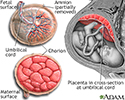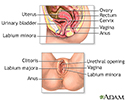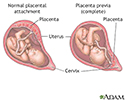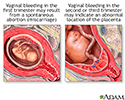Multimedia Gallery
Irritable bowel syndrome
Are your off again, on again, bathroom habits affecting your daily life?
If so, you may have Irritable Bowel Syndrome, or IBS.
IBS is a problem that causes abdominal pain, cramping, and changes in your bowel movements. IBS is known as a "functional bowel disorder", and is not considered a disease. What I mean by that, is when a doctor passes a colonoscope into the colon to look around, everything may look perfectly normal - but yet, Your colon may not be not be acting normal at all!
Symptoms of IBS can range from mild to severe. The main symptoms are diarrhea, constipation, or both...and you will probably experience abdominal pain, bloating, & gas.
These symptoms often will temporarily improve after having a bowel movement, and that instant relief of course feels good. But, the important thing to understand is that the root of the problem often isn't "here" (abdomen), its "here" (head). IBS is a classic example of your mind affecting your bowels. It's rarely seen in folks who are not stressed, anxious, or depressed.
It's often hard to determine why people get IBS. It has been found that IBS is twice as common in women as it is in men, and can develop at any age, but most get it as teenagers or in early adulthood.
Diet can also cause IBS. Foods that often cause IBS symptoms are Fatty foods, such as French fries, or any drink containing caffeine like coffee and tea.
One great idea is to keep a Food Diary. Write down what you're eating and when, and include the symptoms you experience after you eat. This information can be helpful to your doctor in identifying if you have IBS.
The way most doctors diagnose IBS is by gathering your history and ruling out other things like lactose intolerance, gluten intolerance or some sort of bowel infection. Your doctor might recommend a colonoscopy just to make sure the colon looks okay. But remember, there is no specific test to diagnose IBS.
So, how do you manage IBS?
For some people, symptoms can reduce their ability to work, travel, and attend social events, and some may have to deal with IBS the rest of their life. There are several ways to manage your IBS. Large meals can make your symptoms worse. Try eating 4 to 5 smaller meals per day. Extra Fiber can bulk up your stools to help with diarrhea or help draw in extra water to help with constipation. Laxatives can help with difficult constipation.
Drugs like Hyoscyamine help to calm down an overactive digestive tract. Lastly, since stress, depression and anxiety can fuel IBS, work on ways to relax. Perhaps, try exercise, meditation or yoga - and if that doesn't work, consider trying an antidepressant drug to help improve your mood.
Oh, and keep in mind that blood in your stool or significant weight loss are not part of IBS, so be sure to let your doctor know if that ever shows up. Remember that the mind and the body are interconnected. You can't expect to feel good "here" (head), without feeling good down "here" (abdomen), and vice versa.
Irritable bowel syndrome
Review Date: 4/21/2025
Reviewed By: Todd Eisner, MD, Private practice specializing in Gastroenterology in Boca Raton and Delray Beach, Florida at Gastroenterology Consultants of Boca Raton. Affiliate Assistant Professor, Florida Atlantic University School of Medicine. Review provided by VeriMed Healthcare Network. Also reviewed by David C. Dugdale, MD, Medical Director, Brenda Conaway, Editorial Director, and the A.D.A.M. Editorial team.
Animations
- Abdominal aortic aneurysm
- Abdominal pain
- ACL injury
- Acne
- Alcoholic liver disease
- Allergic rhinitis
- Allergies
- Allergy testing
- Allergy to mold - animal da...
- Alzheimer disease
- Alzheimer disease
- Anemia
- Ankylosing spondylitis
- Anterior shoulder stretch
- Anti-reflux surgery
- Appendectomy
- Appendicitis
- Arm reach
- Arthritis
- Asthma
- Atherosclerosis
- Atopic dermatitis
- Atrial fibrillation
- Basal cell carcinoma
- Bipolar disorder
- Bladder function - neurolog...
- Breast cancer
- Breast engorgement
- Breast lift
- Breast self-exam
- Breastfeeding
- Bronchitis
- Bronchoscopy
- Bunion
- Cardiac catheterization
- Carpal tunnel syndrome
- Cataract
- Cataracts
- Cell division
- Cervical cancer
- Cesarean section
- Chest pain
- Cholesterol and triglycerid...
- Chronic obstructive pulmona...
- Cluster headache
- Colon cancer
- Colorectal polyps
- Common cold
- Conception - general
- Conception - pregnancy
- Conception of identical twins
- Concussion
- Cosmetic surgery of the face
- Crohn disease
- C-section
- Depression
- Diabetes
- Dialysis
- Diarrhea
- Early labor
- Egg cell production
- Egg production
- Electrocardiogram
- Endometriosis
- Epilepsy
- Essential hypertension
- External rotation with band
- Fibromyalgia
- Flu
- Food poisoning
- Foot pain
- Formation of twins
- Gallstones
- Gastroesophageal reflux disease
- Getting rid of lice in the home
- Glaucoma
- Hardening of arteries
- HbA1c
- Head injury
- Healthy Guide to Fast Food
- Hearing loss
- Heart attack
- Heart failure
- Heartburn
- Heel pain
- Hepatitis A
- Hepatitis B
- Hepatitis C
- Hernia
- Herniated disk
- Hip joint replacement
- Hodgkin lymphoma
- How to remove a splinter
- How to treat a nosebleed
- How to treat a sunburn
- How to use a peak flow meter
- How to use a pill cutter
- How to use eye drops
- How to use nasal sprays
- Hypertension
- Hyperthyroidism
- Hypothyroidism
- Hysterectomy
- Insomnia
- Internal rotation with band
- Iron deficiency anemia
- Irritable bowel syndrome
- Isometric
- Kidney stones
- Kidney stones
- Knee joint replacement
- Let's talk about pink eye
- Liposuction
- Lung cancer
- Lyme disease
- Lymphatics and the breast
- Melanoma
- Menopause
- Migraine
- Multiple sclerosis
- Nasal congestion
- Neck pain
- Nuclear stress test
- Obstructive sleep apnea
- Osteoarthritis
- Osteoarthritis
- Osteoporosis
- Osteoporosis
- Ovulation
- Pap smear
- Pendulum exercise
- Peptic ulcer
- Pharyngitis
- Placenta delivery
- Placenta formation
- Plantar fasciitis
- Pneumonia
- Preeclampsia
- Pregnancy
- Pregnancy care
- Psoriasis
- Rheumatoid arthritis
- Rotator cuff problems
- Rupturing membranes
- Sciatica
- Seizures
- Shingles
- Shoulder blade retraction
- Shoulder blade retraction w...
- Shoulder pain
- Sinusitis
- Sleep disorders
- Smoking tips to quit
- Snoring
- Spinal stenosis
- Stent
- Storing breast milk
- Strep throat
- Stretching back of your shoulder
- Stroke
- Systemic lupus erythematosus
- Tension headache
- The difference between a co...
- The role of amniotic fluid
- Tips on buying cold and flu...
- Tips on removing ear wax
- Tracking your blood pressur...
- Treating eyelid bumps
- Twin-to-twin transfusion sy...
- Type 2 diabetes
- Ulcerative colitis
- Ultrasound
- Understanding cholesterol r...
- Up the back stretch
- Urinary incontinence
- Urinary tract infection - adults
- Uterine fibroids
- Vacation health care
- Vaginal delivery
- Varicose veins
- Venous insufficiency
- Wall push-up
- Wall stretch
- Warts
- What are hives?
- What causes wheezing?
- What in the world is a neti pot?
- What is tennis elbow?
- What makes your heart beat?
- What to do when something g...
Illustrations
- 3D ultrasound
- Abnormal discharge from the...
- Abnormal menstrual periods
- Absence of menstruation (am...
- Amniocentesis
- Amniotic fluid
- Anatomy of a normal placenta
- Anterior vaginal wall repair
- Bleeding between periods
- Breast infection
- Breast lumps
- Breast pain
- Breast self-exam
- Breast self-exam
- Breast self-exam
- Breastfeeding
- Causes of breast lumps
- Causes of breast lumps
- Causes of painful intercourse
- Causes of sexual dysfunction
- Causes of vaginal itching
- Cervical biopsy
- Cervical cancer
- Cervical cancer
- Cervical cryosurgery
- Cervical cryosurgery
- Cervical erosion
- Cervical neoplasia
- Cervical polyps
- Cervicitis
- Cervix needle sample
- Cesarean section
- Cesarean section
- Cesarean section
- Childbirth
- Cold cone removal
- Colposcopy-directed biopsy
- Culdocentesis
- D and C
- Delivery presentations
- Depression and the menstrua...
- Developmental disorders of ...
- Early pregnancy
- Early weeks of pregnancy
- Ectopic pregnancy
- Emergency Childbirth
- Emergency Childbirth
- Endometrial biopsy
- Endometrial biopsy
- Endometrial cancer
- Endometriosis
- Endometritis
- Episiotomy aftercare
- Excision of breast lump
- Female breast
- Female perineal anatomy
- Female reproductive anatomy
- Female reproductive anatomy
- Female reproductive anatomy...
- Female urinary tract
- Female-pattern baldness
- Fibrocystic breast change
- Fibroid tumors
- First trimester of pregnancy
- Folic acid
- Genetic counseling and pren...
- Gestational ages
- Gestational diabetes
- Hysterectomy
- Inflatable artificial sphincter
- Intraductal papilloma
- Lumpectomy
- Mammary gland
- Mammography
- Mammoplasty
- Menopause
- Morning sickness
- Nabothian cyst
- Necrobiosis lipoidica diabe...
- Necrobiosis lipoidica diabe...
- Needle biopsy of the breast
- Normal female anatomy
- Normal female breast anatomy
- Normal uterine anatomy (cut...
- Open biopsy of the breast
- Oral glucose tolerance test
- Ovarian cancer
- Ovarian cancer dangers
- Ovarian cancer metastasis
- Ovarian cyst
- Ovarian cysts
- Ovarian growth worries
- Pap smear
- Pap smear
- Pap smears and cervical cancer
- Pelvic adhesions
- Pelvic laparoscopy
- Peritoneal and ovarian canc...
- Placenta
- Placenta
- Placenta
- Placenta previa
- Preeclampsia
- Pregnancy test
- Premenstrual bloating
- Prevention of cystitis
- Primary amenorrhea
- Relief of menstrual cramps
- Relieving PMS
- Rotator cuff muscles
- Secondary amenorrhea
- Side sectional view of fema...
- Stein-Leventhal syndrome
- Stress incontinence
- Stress incontinence
- Teratoma - MRI scan
- The wet mount vaginitis test
- Threatened miscarriage
- Transvaginal ultrasound
- Ultrasound comparison
- Ultrasound in pregnancy
- Ureteral biopsy
- Uterine anatomy
- Uterus
- Vaginal bleeding during pre...
- Vaginal discharge
- Yeast infections
Presentations
- Achalasia - series
- Adenoid removal - series
- Animal bite - first aid - series
- Ankle sprain - Series
- Appendectomy - series
- Bone fracture repair - series
- Bone-marrow transplant - series
- Bruise healing - series
- Cataract surgery - series
- Chest tube insertion - series
- Choking first aid - adult o...
- Choking first aid - infant ...
- Circumcision - series
- Cleft lip repair - series
- Clubfoot repair - series
- Colon cancer - series
- Complete blood count - series
- Convulsions - first aid - series
- CPR - child 1 to 8 years ol...
- CPR - infant - series
- Craniotomy - series
- Diaphragmatic hernia repair...
- Ear tube insertion - series
- Eardrum repair - series
- Emergency airway puncture ...
- Exchange transfusion - series
- Gastroesophageal reflux - series
- Gastroschisis repair - series
- Heart valve surgery - series
- Hemangioma excision - series
- Hiatal hernia repair - series
- Hydrocele repair - series
- Hypospadias repair - series
- Imperforate anus repair - ...
- Infantile pyloric stenosis ...
- Inflammatory bowel disease ...
- Inguinal hernia repair - series
- Intestinal obstruction (ped...
- Intestinal obstruction repa...
- Large bowel resection - series
- Leg lengthening - series
- Mastoidectomy - series
- Meckel's diverticulectomy ...
- Meningocele repair - series
- Metered dose inhaler use - ...
- Minor burn - first aid - series
- Minor cut - first aid
- Monitoring blood glucose - ...
- Nebulizer use - series
- Omphalocele repair - series
- Pancreatitis - series
- Patent ductus arteriosis (P...
- Patent urachus repair - series
- Pectus excavatum repair - ...
- Pneumothorax - series
- Repair of webbed fingers -...
- Retinal detachment repair ...
- Rh incompatibility - series
- Small bowel resection - series
- Spleen removal - series
- Thyroidectomy - series
- Tonsillectomy - series
- Tracheoesophageal fistula r...
- Two person roll - series
- Umbilical hernia repair - ...
- Ventriculoperitoneal shunt ...
- White blood cell count - series

 Bookmark
Bookmark

































































































































































































































































































































































































